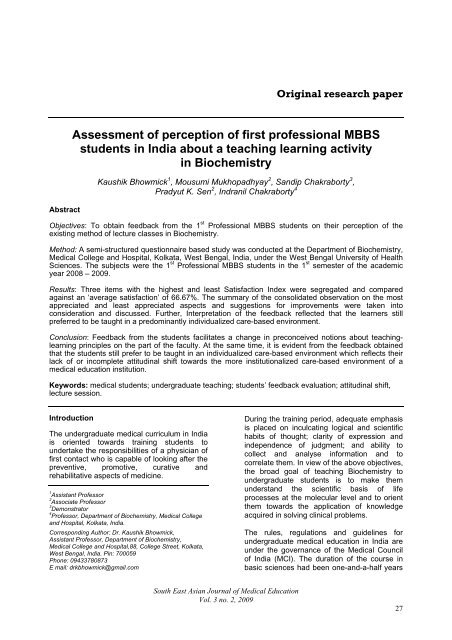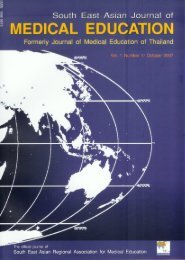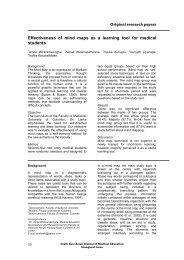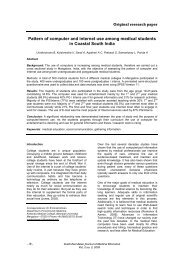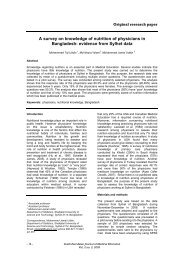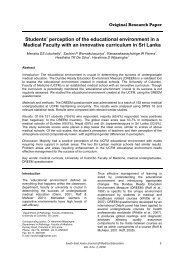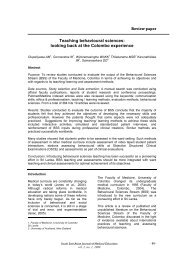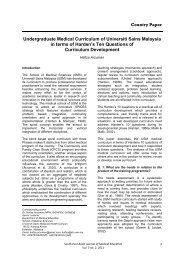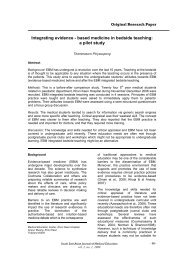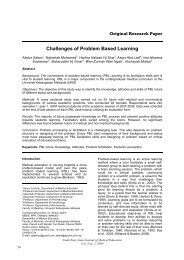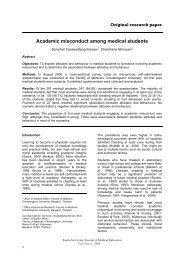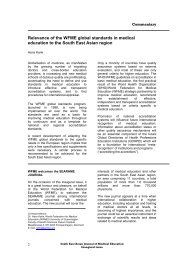Assessment of perception of first professional MBBS students in ...
Assessment of perception of first professional MBBS students in ...
Assessment of perception of first professional MBBS students in ...
Create successful ePaper yourself
Turn your PDF publications into a flip-book with our unique Google optimized e-Paper software.
Orig<strong>in</strong>al research paper<br />
Abstract<br />
<strong>Assessment</strong> <strong>of</strong> <strong>perception</strong> <strong>of</strong> <strong>first</strong> pr<strong>of</strong>essional <strong>MBBS</strong><br />
<strong>students</strong> <strong>in</strong> India about a teach<strong>in</strong>g learn<strong>in</strong>g activity<br />
<strong>in</strong> Biochemistry<br />
Kaushik Bhowmick 1 , Mousumi Mukhopadhyay 2 , Sandip Chakraborty 3 ,<br />
Pradyut K. Sen 2 , Indranil Chakraborty 4<br />
Objectives: To obta<strong>in</strong> feedback from the 1 st Pr<strong>of</strong>essional <strong>MBBS</strong> <strong>students</strong> on their <strong>perception</strong> <strong>of</strong> the<br />
exist<strong>in</strong>g method <strong>of</strong> lecture classes <strong>in</strong> Biochemistry.<br />
Method: A semi-structured questionnaire based study was conducted at the Department <strong>of</strong> Biochemistry,<br />
Medical College and Hospital, Kolkata, West Bengal, India, under the West Bengal University <strong>of</strong> Health<br />
Sciences. The subjects were the 1 st Pr<strong>of</strong>essional <strong>MBBS</strong> <strong>students</strong> <strong>in</strong> the 1 st semester <strong>of</strong> the academic<br />
year 2008 – 2009.<br />
Results: Three items with the highest and least Satisfaction Index were segregated and compared<br />
aga<strong>in</strong>st an ‘average satisfaction’ <strong>of</strong> 66.67%. The summary <strong>of</strong> the consolidated observation on the most<br />
appreciated and least appreciated aspects and suggestions for improvements were taken <strong>in</strong>to<br />
consideration and discussed. Further, Interpretation <strong>of</strong> the feedback reflected that the learners still<br />
preferred to be taught <strong>in</strong> a predom<strong>in</strong>antly <strong>in</strong>dividualized care-based environment.<br />
Conclusion: Feedback from the <strong>students</strong> facilitates a change <strong>in</strong> preconceived notions about teach<strong>in</strong>glearn<strong>in</strong>g<br />
pr<strong>in</strong>ciples on the part <strong>of</strong> the faculty. At the same time, it is evident from the feedback obta<strong>in</strong>ed<br />
that the <strong>students</strong> still prefer to be taught <strong>in</strong> an <strong>in</strong>dividualized care-based environment which reflects their<br />
lack <strong>of</strong> or <strong>in</strong>complete attitud<strong>in</strong>al shift towards the more <strong>in</strong>stitutionalized care-based environment <strong>of</strong> a<br />
medical education <strong>in</strong>stitution.<br />
Keywords: medical <strong>students</strong>; undergraduate teach<strong>in</strong>g; <strong>students</strong>’ feedback evaluation; attitud<strong>in</strong>al shift,<br />
lecture session.<br />
Introduction<br />
The undergraduate medical curriculum <strong>in</strong> India<br />
is oriented towards tra<strong>in</strong><strong>in</strong>g <strong>students</strong> to<br />
undertake the responsibilities <strong>of</strong> a physician <strong>of</strong><br />
<strong>first</strong> contact who is capable <strong>of</strong> look<strong>in</strong>g after the<br />
preventive, promotive, curative and<br />
rehabilitative aspects <strong>of</strong> medic<strong>in</strong>e.<br />
1<br />
Assistant Pr<strong>of</strong>essor<br />
2<br />
Associate Pr<strong>of</strong>essor<br />
3<br />
Demonstrator<br />
4<br />
Pr<strong>of</strong>essor, Department <strong>of</strong> Biochemistry, Medical College<br />
and Hospital, Kolkata, India.<br />
Correspond<strong>in</strong>g Author: Dr. Kaushik Bhowmick,<br />
Assistant Pr<strong>of</strong>essor, Department <strong>of</strong> Biochemistry,<br />
Medical College and Hospital,88, College Street, Kolkata,<br />
West Bengal, India. P<strong>in</strong>: 700059<br />
Phone: 09433780873<br />
E mail: drkbhowmick@gmail.com<br />
Dur<strong>in</strong>g the tra<strong>in</strong><strong>in</strong>g period, adequate emphasis<br />
is placed on <strong>in</strong>culcat<strong>in</strong>g logical and scientific<br />
habits <strong>of</strong> thought; clarity <strong>of</strong> expression and<br />
<strong>in</strong>dependence <strong>of</strong> judgment; and ability to<br />
collect and analyse <strong>in</strong>formation and to<br />
correlate them. In view <strong>of</strong> the above objectives,<br />
the broad goal <strong>of</strong> teach<strong>in</strong>g Biochemistry to<br />
undergraduate <strong>students</strong> is to make them<br />
understand the scientific basis <strong>of</strong> life<br />
processes at the molecular level and to orient<br />
them towards the application <strong>of</strong> knowledge<br />
acquired <strong>in</strong> solv<strong>in</strong>g cl<strong>in</strong>ical problems.<br />
The rules, regulations and guidel<strong>in</strong>es for<br />
undergraduate medical education <strong>in</strong> India are<br />
under the governance <strong>of</strong> the Medical Council<br />
<strong>of</strong> India (MCI). The duration <strong>of</strong> the course <strong>in</strong><br />
basic sciences had been one-and-a-half years<br />
South East Asian Journal <strong>of</strong> Medical Education<br />
Vol. 3 no. 2, 2009<br />
27
compris<strong>in</strong>g <strong>of</strong> three semesters until the year<br />
2000. Subsequently, as per recommendations<br />
<strong>of</strong> the MCI, the duration has been reduced to<br />
one year compris<strong>in</strong>g <strong>of</strong> two semesters. The<br />
knowledge <strong>in</strong> biomedical sciences is<br />
progress<strong>in</strong>g <strong>in</strong> leaps and bounds. Consequently,<br />
a reform <strong>in</strong> undergraduate teach<strong>in</strong>g is the need<br />
<strong>of</strong> the hour. On the other hand, MCI has<br />
specified 240 hours <strong>of</strong> teach<strong>in</strong>g for completion<br />
<strong>of</strong> the curriculum <strong>in</strong> this discipl<strong>in</strong>e (Regulations<br />
on Graduate Medical Education, 1997). Hence<br />
judicious and optimum utilization <strong>of</strong> these<br />
teach<strong>in</strong>g hours is <strong>of</strong> utmost importance for<br />
atta<strong>in</strong><strong>in</strong>g the specified objectives. In this regard,<br />
the Department <strong>of</strong> Biochemistry, Medical<br />
College, Kolkata, follows a systematic policy for<br />
lectures, which <strong>in</strong>volves division <strong>of</strong> each broad<br />
section <strong>in</strong>to a requisite number <strong>of</strong> <strong>in</strong>dividual<br />
lectures and outl<strong>in</strong><strong>in</strong>g the specific learn<strong>in</strong>g<br />
objectives for each <strong>of</strong> these classes <strong>in</strong><br />
accordance with the guidel<strong>in</strong>es laid down by the<br />
MCI. This system permits the assignment <strong>of</strong><br />
each lecture to a particular faculty member<br />
without the possibility <strong>of</strong> omission or repetition <strong>of</strong><br />
any part <strong>of</strong> the topic, while simultaneously<br />
ensur<strong>in</strong>g that any particular section is covered<br />
by a group <strong>of</strong> speakers thus avoid<strong>in</strong>g bias and<br />
monotony.<br />
Moreover, <strong>in</strong> the state <strong>of</strong> West Bengal, there has<br />
been a change <strong>in</strong> the scenario <strong>of</strong> medical<br />
education with the establishment <strong>of</strong> West<br />
Bengal University <strong>of</strong> Health Sciences (WBUHS)<br />
<strong>in</strong> the year 2003 (Statutes <strong>of</strong> the West Bengal<br />
University <strong>of</strong> Health Sciences). All the medical<br />
colleges <strong>in</strong> the state that were under the purview<br />
<strong>of</strong> different universities were brought under<br />
WBUHS <strong>in</strong> an attempt to ensure uniformity <strong>in</strong><br />
syllabus, teach<strong>in</strong>g and evaluation procedures.<br />
Subsequently, the University formulated a<br />
revised syllabus <strong>in</strong> accordance with the<br />
curriculum recommended by the MCI <strong>in</strong> the year<br />
2003 (Syllabus <strong>in</strong> Biochemistry for 1 st<br />
Pr<strong>of</strong>essional <strong>MBBS</strong> <strong>of</strong> the West Bengal<br />
University <strong>of</strong> Health Sciences). This syllabus<br />
has outl<strong>in</strong>ed the specific learn<strong>in</strong>g objectives <strong>of</strong><br />
each lecture and the total hours <strong>of</strong> lectures<br />
required for completion <strong>of</strong> the syllabus. The<br />
University has been conduct<strong>in</strong>g the 1 st<br />
Pr<strong>of</strong>essional Exam<strong>in</strong>ation for the last four years.<br />
Hence, it is deemed to be the ripe time to<br />
assess the <strong>students</strong>’ <strong>perception</strong> <strong>of</strong> the<br />
usefulness and relevance with regard to content<br />
<strong>of</strong> the syllabus, teach<strong>in</strong>g-learn<strong>in</strong>g methods and<br />
teach<strong>in</strong>g-learn<strong>in</strong>g media.<br />
In addition, a majority <strong>of</strong> the <strong>students</strong> who are<br />
admitted to the undergraduate medical course <strong>in</strong><br />
India come through an elaborate system <strong>of</strong><br />
private tuitions and coach<strong>in</strong>g classes dur<strong>in</strong>g<br />
their ‘10+2’ level. This makes them habituated to<br />
learn<strong>in</strong>g <strong>in</strong> an <strong>in</strong>dividualized care-based<br />
environment. Hence these <strong>students</strong> have to<br />
cope with a drastically different set up when<br />
they attend the <strong>first</strong> semester lecture classes <strong>in</strong><br />
a medical college.<br />
Therefore, the present study was undertaken to<br />
elicit the <strong>perception</strong> <strong>of</strong> the <strong>students</strong> regard<strong>in</strong>g<br />
the utility <strong>of</strong> the prevail<strong>in</strong>g system <strong>of</strong> lectures<br />
and to evaluate the extent to which the <strong>students</strong><br />
are benefited by these teach<strong>in</strong>g methodologies.<br />
For this purpose, a semi-structured evaluation<br />
questionnaire was developed with the scope <strong>of</strong><br />
giv<strong>in</strong>g <strong>in</strong>dividual op<strong>in</strong>ion on content <strong>of</strong> the<br />
syllabus, teach<strong>in</strong>g-learn<strong>in</strong>g (T-L) methods and<br />
teach<strong>in</strong>g-learn<strong>in</strong>g (T-L) media. It was perceived<br />
that this feedback obta<strong>in</strong>ed from <strong>students</strong> could<br />
then be used to modify the mode <strong>of</strong> impart<strong>in</strong>g<br />
knowledge accord<strong>in</strong>g to the <strong>students</strong>’ perceived<br />
learn<strong>in</strong>g needs. Also, an assessment <strong>of</strong> the<br />
attitud<strong>in</strong>al shift <strong>of</strong> these <strong>students</strong> may be<br />
performed from their feedback to gauge how far<br />
they have been able to cope with the exist<strong>in</strong>g<br />
predom<strong>in</strong>antly <strong>in</strong>stitutionalized care-based<br />
medical education system.<br />
Materials and Methods<br />
The <strong>first</strong> semester <strong>students</strong> who had completed<br />
3 months <strong>of</strong> the curriculum were selected for the<br />
study. A total <strong>of</strong> 107 respondents were selected<br />
by random sampl<strong>in</strong>g from the total student<br />
strength <strong>of</strong> 157 after hav<strong>in</strong>g obta<strong>in</strong>ed their<br />
<strong>in</strong>formed consent. The questionnaire devised for<br />
the present study was divided <strong>in</strong>to three<br />
sections viz. A, B and C. Sections A and B<br />
consisted <strong>of</strong> ten questions with three options<br />
each. The <strong>students</strong> were <strong>in</strong>structed to pick the<br />
option to each question which they felt was most<br />
appropriate. The respondents were also<br />
encouraged to furnish their <strong>in</strong>dependent and<br />
unbiased op<strong>in</strong>ion regard<strong>in</strong>g certa<strong>in</strong> other<br />
aspects <strong>of</strong> T-L pr<strong>in</strong>ciples viz. th<strong>in</strong>gs most<br />
appreciated, th<strong>in</strong>gs least appreciated,<br />
suggestions for improvement and any other<br />
remarks <strong>in</strong> section C <strong>of</strong> the questionnaire. The<br />
participants were also <strong>in</strong>structed not to provide<br />
any personal <strong>in</strong>formation, nor to reveal their<br />
identity <strong>in</strong> the questionnaire. Further, the<br />
<strong>students</strong> were discouraged to put <strong>in</strong> writ<strong>in</strong>g any<br />
<strong>in</strong>dividualized comment about the faculty<br />
members or their way <strong>of</strong> teach<strong>in</strong>g. The<br />
completed response sheets were collected and<br />
statistically analysed to compute the results<br />
us<strong>in</strong>g Micros<strong>of</strong>t Excel.<br />
28<br />
South East Asian Journal <strong>of</strong> Medical Education<br />
Vol. 3 no. 2, 2009
Results<br />
The responses obta<strong>in</strong>ed under section A, were<br />
statistically treated to calculate the Satisfaction<br />
Indices (SI) for each item there<strong>in</strong> (Guilbert,<br />
1991). ‘Average Satisfaction’ for the particular<br />
method and parameters for calculation <strong>of</strong> SI was<br />
66.67 %. These results are depicted <strong>in</strong> table 1.<br />
Table 1: Satisfaction Indices (%) <strong>of</strong> responses (n = 107) for items <strong>in</strong> Section A <strong>of</strong> the questionnaire<br />
Teach<strong>in</strong>g – Learn<strong>in</strong>g Process<br />
1. Are the objectives (what is to be taught) clearly outl<strong>in</strong>ed at the beg<strong>in</strong>n<strong>in</strong>g<br />
<strong>of</strong> each lecture class<br />
Satisfaction<br />
Index (%)*<br />
82.78<br />
2. Do you generally understand the concepts outl<strong>in</strong>ed 85.89<br />
3. Do your teachers give enough opportunity to clarify your doubts 75.00<br />
4. Do you th<strong>in</strong>k that the language <strong>of</strong> presentation is simple 94.60<br />
5. Are the topics <strong>of</strong> lecture arranged <strong>in</strong> logical sequence well suited to your<br />
understand<strong>in</strong>g<br />
81.23<br />
6. Do you th<strong>in</strong>k cont<strong>in</strong>uity between <strong>in</strong>dividual lectures is ma<strong>in</strong>ta<strong>in</strong>ed adequately 74.07<br />
7. Do you th<strong>in</strong>k your teachers encourage <strong>in</strong>teractive learn<strong>in</strong>g <strong>in</strong> the form <strong>of</strong> ask<strong>in</strong>g or<br />
rais<strong>in</strong>g questions themselves or allow<strong>in</strong>g you to ask questions<br />
87.14<br />
8. Are the most important po<strong>in</strong>ts summarized at the end <strong>of</strong> a presentation 66.60<br />
* Statistical Calculation for comput<strong>in</strong>g the Satisfaction Indices <strong>in</strong> Table 1 yielded an ‘Average Satisfaction’ <strong>of</strong> 66.67%.<br />
The percentage <strong>of</strong> responses for section B is<br />
depicted <strong>in</strong> figure 1. The consolidated<br />
observations for number <strong>of</strong> appraisals regard<strong>in</strong>g<br />
overall assessment <strong>in</strong> section C <strong>of</strong> the<br />
questionnaire are presented <strong>in</strong> figures 2, 3 and 4.<br />
Figure 1: Percentage <strong>of</strong> responses (n = 107) for items <strong>in</strong> Section B <strong>of</strong> the questionnaire<br />
You th<strong>in</strong>k you will learn better if each section is<br />
23<br />
completely taught by a s<strong>in</strong>gle teacher<br />
divided <strong>in</strong>to different topics each taught by different teachers<br />
77<br />
You understand better when teachers use<br />
30<br />
62<br />
8<br />
Chalkboard Projection media Both<br />
South East Asian Journal <strong>of</strong> Medical Education<br />
Vol. 3 no. 2, 2009<br />
29
Figure 2: Number <strong>of</strong> Appraisals for ‘Most Appreciated Aspects’ <strong>of</strong> Lecture Presentations<br />
Number <strong>of</strong> appraisals<br />
7<br />
6<br />
5<br />
4<br />
3<br />
2<br />
1<br />
0<br />
7<br />
6<br />
3<br />
2<br />
Most Appreciated<br />
3<br />
Conceptual mode <strong>of</strong> presentation<br />
Cont<strong>in</strong>uation <strong>of</strong> a s<strong>in</strong>gle topic <strong>in</strong> simultaneous lectures<br />
Judicious use <strong>of</strong> T-L media<br />
Ma<strong>in</strong>ta<strong>in</strong>ance <strong>of</strong> connectivity and coherence between lectures<br />
Summaris<strong>in</strong>g at the end <strong>of</strong> a session with overview <strong>of</strong> next<br />
topic<br />
Figure 3: Number <strong>of</strong> appraisals for 'Least Appreciated Aspects' <strong>of</strong> Lecture presentations<br />
25<br />
23<br />
Number <strong>of</strong> appraisals<br />
20<br />
15<br />
10<br />
5<br />
0<br />
14<br />
11<br />
5<br />
Least Appreciated<br />
2<br />
Monotonous 'one-way' mode <strong>of</strong> communiction<br />
Dim<strong>in</strong>ished scope for clarification <strong>of</strong> doubts<br />
Injudicious use <strong>of</strong> T-L media (particularly 'Projected media')<br />
Poor audibility <strong>of</strong> a lecture presentation<br />
Poor visibility <strong>of</strong> T-L media<br />
30<br />
South East Asian Journal <strong>of</strong> Medical Education<br />
Vol. 3 no. 2, 2009
Figure 4: Number <strong>of</strong> <strong>students</strong>' appraisals for suggestions for improvement <strong>of</strong> a lecture Presentation<br />
Number <strong>of</strong> appraisals<br />
20<br />
15<br />
10<br />
5<br />
0<br />
17<br />
10<br />
14<br />
13 13<br />
Suggestions<br />
8<br />
11<br />
4<br />
More <strong>in</strong>teractive session with schematic presentations<br />
Better quality <strong>of</strong> slides and more time alloted to each slide<br />
while us<strong>in</strong>g projected media<br />
More use <strong>of</strong> microphones and sound system<br />
Evaluation <strong>of</strong> learners at frequent <strong>in</strong>tervals improve learn<strong>in</strong>g<br />
outcome <strong>of</strong> lectures<br />
Group discussions and <strong>in</strong>teractive session improve learn<strong>in</strong>g<br />
outcome <strong>of</strong> lectures<br />
Summaris<strong>in</strong>g <strong>of</strong> important concepts at the end <strong>of</strong> a session<br />
improves learn<strong>in</strong>g outcome<br />
More stress on applied and cl<strong>in</strong>ical aspects<br />
More use <strong>of</strong> chalkboard <strong>in</strong> preference to other T-L media<br />
Discussion<br />
An evaluation made by <strong>students</strong> can<br />
provide the teacher with useful feedback<br />
<strong>in</strong>formation, obta<strong>in</strong>ed through <strong>in</strong>formal<br />
mutual communication or preferably by a<br />
designed questionnaire. Many<br />
psychometric studies have revealed the<br />
validity and accuracy <strong>of</strong> <strong>students</strong>’ op<strong>in</strong>ion<br />
as well as their close correlation with<br />
‘objective’ measurements <strong>of</strong> the<br />
<strong>in</strong>structor’s effectiveness. The many<br />
biases which were earlier ascribed to the<br />
student evaluators have mostly proved to<br />
be <strong>of</strong> negligible importance (d’Lvernois,<br />
1991). Therefore the present study has<br />
been designed <strong>in</strong> the form <strong>of</strong> a<br />
questionnaire with the objective to elicit<br />
the <strong>perception</strong> <strong>of</strong> the <strong>students</strong> regard<strong>in</strong>g<br />
the utility <strong>of</strong> the prevail<strong>in</strong>g system <strong>of</strong><br />
lectures and to evaluate the extent to<br />
which the <strong>students</strong> are benefited by these<br />
T-L methodologies.<br />
The questionnaire was subdivided <strong>in</strong>to<br />
three sections viz. A, B and C. Section A<br />
comprised <strong>of</strong> 8 items which the <strong>students</strong><br />
were asked to score on a three-po<strong>in</strong>t scale<br />
each. In order to arrive at a general<br />
consensus regard<strong>in</strong>g the total positive<br />
trend <strong>of</strong> each response, the ‘Satisfaction<br />
Index’ (%) aga<strong>in</strong>st each was calculated.<br />
As per criteria, the ‘average satisfaction’, a<br />
statistical measure for denot<strong>in</strong>g the<br />
watershed mark <strong>of</strong> positivity <strong>of</strong> responses<br />
for the present study was calculated to be<br />
66.67%. Although the calculated SI for<br />
each question under this section was<br />
above the average value, three items with<br />
the highest SI were related to simple<br />
South East Asian Journal <strong>of</strong> Medical Education<br />
Vol. 3 no. 2, 2009<br />
31
language <strong>of</strong> presentation, encouragement<br />
<strong>of</strong> <strong>in</strong>teractive learn<strong>in</strong>g on the part <strong>of</strong><br />
teachers and proper understand<strong>in</strong>g <strong>of</strong> the<br />
outl<strong>in</strong>ed concepts. On the other hand,<br />
three items that had least SI were related<br />
to summarization <strong>of</strong> important po<strong>in</strong>ts at the<br />
end <strong>of</strong> the presentation, ma<strong>in</strong>tenance <strong>of</strong><br />
cont<strong>in</strong>uity between <strong>in</strong>dividual lectures and<br />
scope for clarification <strong>of</strong> doubts. In a<br />
similar study, Garg et al. (2004) elicited<br />
the <strong>students</strong>’ op<strong>in</strong>ion about the quality <strong>of</strong><br />
lectures. A majority <strong>of</strong> <strong>students</strong> op<strong>in</strong>ed that<br />
the lectures as a whole were <strong>in</strong>formative<br />
and <strong>in</strong>terest<strong>in</strong>g. However, 20% <strong>of</strong> the<br />
student evaluators felt that most <strong>of</strong> the<br />
lectures were bor<strong>in</strong>g and only a few were<br />
<strong>in</strong>terest<strong>in</strong>g. Thus from the present study,<br />
the authors op<strong>in</strong>ed that a few<br />
modifications <strong>in</strong> the plann<strong>in</strong>g <strong>of</strong> each<br />
lecture session may prove beneficial. In<br />
this context, Anantkrishnan (2000) has<br />
stressed the importance <strong>of</strong> microteach<strong>in</strong>g<br />
sessions for teachers as a preparatory<br />
vehicle for impart<strong>in</strong>g quality teach<strong>in</strong>g. The<br />
present study highlights that<br />
summarization <strong>of</strong> key concepts at the end<br />
<strong>of</strong> a lecture, an essential and very<br />
important part <strong>of</strong> any lecture session, was<br />
not be<strong>in</strong>g practiced to the desired extent.<br />
This may be ascribed to a paucity <strong>of</strong> time<br />
towards the end <strong>of</strong> the class. This same<br />
reason may be attributed to the teachers’<br />
<strong>in</strong>ability to appraise the <strong>students</strong> on the<br />
topics to be covered <strong>in</strong> the next lecture.<br />
These reasons have contributed <strong>in</strong> an<br />
additive manner <strong>in</strong> h<strong>in</strong>der<strong>in</strong>g the<br />
ma<strong>in</strong>tenance <strong>of</strong> cont<strong>in</strong>uity between the<br />
lectures as perceived by the <strong>students</strong>. A<br />
proper prior plann<strong>in</strong>g <strong>of</strong> each lecture<br />
session on the part <strong>of</strong> the lecturer with due<br />
importance on these above mentioned<br />
activities towards the end <strong>of</strong> each session<br />
may prove more beneficial for the<br />
learners. However, as regards to the<br />
<strong>students</strong>’ perceived need for <strong>in</strong>creased<br />
scope for clarification, the authors are <strong>of</strong><br />
the op<strong>in</strong>ion that this can only be dealt with<br />
by encourag<strong>in</strong>g <strong>students</strong> to <strong>in</strong>teract with<br />
their teachers outside the hours <strong>of</strong> lecture<br />
classes.<br />
The responses for Section B <strong>of</strong> the<br />
questionnaire are provided <strong>in</strong> figure 1. A<br />
majority <strong>of</strong> the <strong>students</strong> preferred that<br />
each section be completely taught by a<br />
s<strong>in</strong>gle teacher. But the present practice <strong>in</strong><br />
the authors’ <strong>in</strong>stitution is to divide a s<strong>in</strong>gle<br />
section <strong>in</strong>to different topics (each be<strong>in</strong>g<br />
taught by different teachers) after outl<strong>in</strong><strong>in</strong>g<br />
the specific learn<strong>in</strong>g objectives for each <strong>of</strong><br />
these classes <strong>in</strong> accordance with<br />
guidel<strong>in</strong>es laid down by the MCI. As<br />
mentioned earlier, this system permits the<br />
assignment <strong>of</strong> each lecture to a particular<br />
faculty member without the possibility <strong>of</strong><br />
omission or repetition <strong>of</strong> any part <strong>of</strong> the<br />
topic, while simultaneously ensur<strong>in</strong>g that<br />
any particular section is covered by a<br />
group <strong>of</strong> speakers thus avoid<strong>in</strong>g bias and<br />
monotony. However, the perceived<br />
effectiveness <strong>of</strong> this practice has not been<br />
satisfactory from the <strong>students</strong>’ po<strong>in</strong>t <strong>of</strong><br />
view. One <strong>of</strong> the pr<strong>in</strong>cipal reasons for the<br />
same may be ascribed to a lack <strong>of</strong><br />
cont<strong>in</strong>uity between each lecture session,<br />
as discussed earlier. It is presumed that if<br />
this drawback <strong>in</strong> particular can be properly<br />
addressed, then the prevail<strong>in</strong>g system<br />
may become more acceptable to the<br />
learners. The later part <strong>of</strong> the section B<br />
focused on the utility <strong>of</strong> teach<strong>in</strong>g aids as<br />
preferred by the <strong>students</strong>. A majority <strong>of</strong> the<br />
<strong>students</strong> supported the comb<strong>in</strong>ed use <strong>of</strong><br />
overhead projector with chalk and<br />
blackboard, while a lower percentage was<br />
<strong>in</strong> favour <strong>of</strong> us<strong>in</strong>g only chalk board. Only<br />
7.48% were <strong>in</strong> favour <strong>of</strong> us<strong>in</strong>g the<br />
overhead projector alone.<br />
Section C <strong>of</strong> the questionnaire was an<br />
overall assessment where the <strong>students</strong><br />
were encouraged to put <strong>in</strong> their own<br />
observations regard<strong>in</strong>g the most<br />
appreciated and least appreciated aspects<br />
<strong>of</strong> T-L methodology. In addition, they were<br />
also asked to furnish suggestions for<br />
improvement, for any <strong>of</strong> the exist<strong>in</strong>g T–L<br />
process. The consolidated observations<br />
are provided <strong>in</strong> figures 2, 3 and 4. Though<br />
a majority (52) <strong>of</strong> the respondents<br />
appreciated the attitude and teach<strong>in</strong>g<br />
technique <strong>of</strong> the faculty <strong>in</strong> general, they<br />
have simultaneously po<strong>in</strong>ted out several<br />
lacunae <strong>in</strong> the exist<strong>in</strong>g T-L process which<br />
provided scope for further improvement.<br />
These <strong>in</strong>cluded <strong>in</strong>judicious use <strong>of</strong><br />
projection (23), monotonous one-way<br />
communication (14) and <strong>in</strong>audibility <strong>of</strong> the<br />
lectures (11). The learners provided useful<br />
suggestions regard<strong>in</strong>g mak<strong>in</strong>g the lecture<br />
sessions more <strong>in</strong>teractive (17) along with<br />
<strong>in</strong>clusion <strong>of</strong> group discussions (13). A<br />
similar f<strong>in</strong>d<strong>in</strong>g has also been reported by<br />
Garg et al. (2004) where 34.92 % <strong>of</strong> the<br />
respondents opted for <strong>in</strong>troduction <strong>of</strong><br />
group discussion <strong>in</strong> the teach<strong>in</strong>g<br />
programme. Further suggestions <strong>in</strong>cluded<br />
the use <strong>of</strong> the microphone, which may be<br />
traced to their <strong>in</strong>ability to hear the lectures<br />
clearly as mentioned above and the<br />
32<br />
South East Asian Journal <strong>of</strong> Medical Education<br />
Vol. 3 no. 2, 2009
<strong>in</strong>clusion <strong>of</strong> an evaluation system or items<br />
at regular <strong>in</strong>tervals. Conspicuously, some<br />
respondents (11) have opted for more<br />
stress on applied and cl<strong>in</strong>ical aspects <strong>of</strong><br />
each topic. A similar report from the<br />
College <strong>of</strong> Medic<strong>in</strong>e <strong>of</strong> the University <strong>of</strong><br />
Arkansas, USA, outl<strong>in</strong>es changes <strong>in</strong> the<br />
<strong>students</strong>’ attendance from poor to high on<br />
<strong>in</strong>troduc<strong>in</strong>g changes to teach<strong>in</strong>g methods<br />
such as <strong>in</strong>troduc<strong>in</strong>g cl<strong>in</strong>ically oriented<br />
topics, <strong>in</strong>dependent learn<strong>in</strong>g etc (McMillan<br />
& Wenger, 1987). The f<strong>in</strong>d<strong>in</strong>gs <strong>of</strong> the<br />
present study suggest that it may be<br />
possible to enhance <strong>students</strong>’ <strong>perception</strong><br />
<strong>of</strong> the value <strong>of</strong> a teach<strong>in</strong>g session by<br />
modify<strong>in</strong>g the session <strong>in</strong> the light <strong>of</strong><br />
student’s based evaluation.<br />
Accord<strong>in</strong>g to the prevail<strong>in</strong>g system <strong>of</strong><br />
education <strong>in</strong> India, a transition occurs from<br />
<strong>in</strong>dividualized care <strong>in</strong> ‘10+2’ level to an<br />
<strong>in</strong>stitution-based care dur<strong>in</strong>g their medical<br />
education course. As a result, the <strong>students</strong><br />
face certa<strong>in</strong> difficulties to adapt to this new<br />
environment. This calls for a shift <strong>of</strong><br />
attitude on the part <strong>of</strong> the learners to get<br />
accustomed to this new mode teach<strong>in</strong>glearn<strong>in</strong>g.<br />
Hence, <strong>in</strong> the present study, the<br />
<strong>students</strong>’ feedback obta<strong>in</strong>ed should also<br />
be <strong>in</strong>terpreted <strong>in</strong> this context. Some <strong>of</strong> the<br />
items <strong>in</strong>cluded <strong>in</strong> the questionnaire were<br />
specifically designed to elicit responses to<br />
assess the extent <strong>of</strong> this adaptation. The<br />
observations <strong>of</strong> the study <strong>in</strong> particular, the<br />
f<strong>in</strong>d<strong>in</strong>g that 77% <strong>of</strong> the <strong>students</strong><br />
express<strong>in</strong>g their preference <strong>of</strong> each broad<br />
section to be taught by a s<strong>in</strong>gle teacher,<br />
their ‘suggestions for improvement’<br />
<strong>in</strong>clud<strong>in</strong>g the need <strong>of</strong> more <strong>in</strong>teractive<br />
sessions <strong>in</strong> small groups, <strong>in</strong>creased scope<br />
for clarification <strong>of</strong> doubts, extra tutorial<br />
classes, repetition <strong>of</strong> important concepts,<br />
discussion <strong>of</strong> model questions and<br />
answers and preference for frequent<br />
formative oral evaluation (items) <strong>of</strong><br />
<strong>in</strong>dividual <strong>students</strong> <strong>in</strong> presence <strong>of</strong> a s<strong>in</strong>gle<br />
facilitator - a junior or senior faculty<br />
member, reflected that the learners still<br />
prefer to be taught <strong>in</strong> a predom<strong>in</strong>antly<br />
<strong>in</strong>dividualized care-based environment.<br />
Surpris<strong>in</strong>gly, not a s<strong>in</strong>gle student<br />
mentioned Computer Assisted Learn<strong>in</strong>g<br />
(CAL) as a potential vehicle <strong>of</strong> teach<strong>in</strong>glearn<strong>in</strong>g.<br />
One reason for this could be<br />
ignorance regard<strong>in</strong>g the advantages <strong>of</strong><br />
CAL. In one study on the use <strong>of</strong> CAL<br />
(Bhavsar et al., 1994) it was po<strong>in</strong>ted out by<br />
the authors that a large number <strong>of</strong><br />
<strong>students</strong> expressed the advantages <strong>of</strong><br />
CAL and that if properly <strong>in</strong>troduced, CAL<br />
can go a long way <strong>in</strong> teach<strong>in</strong>g<br />
undergraduate medical <strong>students</strong> <strong>in</strong> future.<br />
The present study, however suffers from<br />
certa<strong>in</strong> drawbacks. The probability for<br />
objectivity would have <strong>in</strong>creased if the<br />
responses had been elicited on a five po<strong>in</strong>t<br />
scale for each question <strong>in</strong>stead <strong>of</strong> the<br />
given three. This would also have been<br />
more appropriate <strong>in</strong> evaluat<strong>in</strong>g the<br />
attitud<strong>in</strong>al parameter <strong>of</strong> the <strong>students</strong>.<br />
Further, the questionnaire had been<br />
designed encompass<strong>in</strong>g a limited aspect <strong>of</strong><br />
the teach<strong>in</strong>g learn<strong>in</strong>g process which was<br />
deemed by the authors to be sufficient for<br />
the objectives <strong>of</strong> the present study.<br />
Thus, it may be concluded from the<br />
present study that the feedback from the<br />
<strong>students</strong> had facilitated a change <strong>in</strong> the<br />
preconceived notions about teach<strong>in</strong>glearn<strong>in</strong>g<br />
pr<strong>in</strong>ciples on the part <strong>of</strong> the<br />
faculty. On the other hand, it should also<br />
be taken <strong>in</strong>to consideration <strong>of</strong> how far the<br />
<strong>in</strong>ability <strong>of</strong> the <strong>students</strong> to cope with the<br />
exist<strong>in</strong>g predom<strong>in</strong>antly <strong>in</strong>stitutionalized<br />
care-based medical education system may<br />
be attributed to a lack <strong>of</strong> or <strong>in</strong>complete<br />
attitud<strong>in</strong>al shift.<br />
References<br />
Ananthkrishnan, N. (2000) Microteach<strong>in</strong>g as a<br />
vehicle <strong>of</strong> teacher tra<strong>in</strong><strong>in</strong>g: An appraisal, In:<br />
Ananthkrishnan N., Sethuraman K.R., & Kumar<br />
S., (eds.) Medical Education: Pr<strong>in</strong>ciples and<br />
practice, 2 nd ed. Pondicherry: JIPMER, pp. 93-<br />
97.<br />
Bhavsar, V.H., Vajpayee, S.K., Joshi, N.J.,<br />
Mistry, S.D., Kantharia, N.D., Sharma, A.K., et<br />
al. (1993) Tra<strong>in</strong><strong>in</strong>g dur<strong>in</strong>g practical<br />
pharmacology sessions for undergraduate<br />
medical <strong>students</strong>: An experience with a<br />
modified teach<strong>in</strong>g programme, Indian Journal<br />
<strong>of</strong> Pharmacology, 31, pp. 176-186.<br />
d’Lvernois, J.F. (1991) Evaluation by <strong>students</strong><br />
<strong>of</strong> programmes, teach<strong>in</strong>g techniques and<br />
teachers, In: Guilbert J.J. (ed.) Educational<br />
handbook for health personnel, 6 th ed. Geneva:<br />
World Health Organization, pp. 4.15-4.19.<br />
Guilbert, J.J. (1991) Workshop <strong>in</strong> educational<br />
plann<strong>in</strong>g, In: Guilbert J.J., (ed.) Educational<br />
handbook for health personnel, 6 th ed. Geneva:<br />
World Health Organization, pp. 5.31.<br />
Garg, A., Rataboli, P.V., & Mulchandi, K.<br />
(2004) Students’ op<strong>in</strong>ion on the prevail<strong>in</strong>g<br />
teach<strong>in</strong>g methods <strong>in</strong> pharmacology and<br />
changes recommended, Indian Journal <strong>of</strong><br />
Pharmacology, 35(3), pp. 155-158.<br />
South East Asian Journal <strong>of</strong> Medical Education<br />
Vol. 3 no. 2, 2009<br />
33
McMillan, D.E. & Wenger, G.R. (1987) Effects<br />
<strong>of</strong> curriculum and format changes <strong>in</strong> a medical<br />
pharmacology course, Academic Medic<strong>in</strong>e, 62,<br />
pp. 836-341.<br />
Medical Council <strong>of</strong> India (1997) Regulations on<br />
Graduate Medical Education (Appendix C).<br />
New Delhi: Medical Council <strong>of</strong> India, pp. 95.<br />
Statutes <strong>of</strong> the West Bengal University <strong>of</strong><br />
Health Sciences [onl<strong>in</strong>e] Available at http://<br />
www.thewbuhs.org/Downloads/statutes_total.p<br />
df. [Accessed January 12 2009]<br />
Syllabus <strong>in</strong> Biochemistry for 1 st Pr<strong>of</strong>essional<br />
<strong>MBBS</strong> <strong>of</strong> the West Bengal University <strong>of</strong> Health<br />
Sciences [onl<strong>in</strong>e]. Available at:<br />
http://www.thewbuhs.org/syllabus/<strong>MBBS</strong>/<br />
Biochemistry.doc [Accessed January 12 2009].<br />
34<br />
South East Asian Journal <strong>of</strong> Medical Education<br />
Vol. 3 no. 2, 2009


